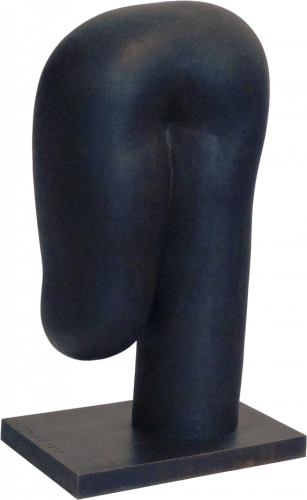
Joannis Avramidis
Joannis Avramidis was born in 1922 in Batumi, Georgia, in the former Soviet Union. The artist lived and worked in Vienna most of his life. Artists born in the same year and of the same generation are Gian Franco Arlandi, Gianni Bertini, Robert Barber, Tomás Maldonado, and H.c. Westermann.
He began studying painting at the state art school, but due to Stalin's ethnic cleansing, this came to an end; his father died in 1937 in prison. After many eventful years and having fled to Athens, he was conscripted in 1943 by the National Socialists and deported as a foreign worker back to Vienna. At the end of the Second World War, he studied painting under Robin Christian Andersen (1945-1949) at the Academy of Fine Arts Vienna, and from 1953 to 1956 attends Fritz Wotrubas' sculpture classes. Since then, the search for the 'absolute figure' stands at the center of his work. Consequently, two eras serve as sources of inspiration for the artist, eras in which the figure and its proportions were held as the measure of all things. These are the classical antiquity and the Italian Renaissance. Avramidis allows the borders between abstraction and figurative depiction to merge in his sculptures. Softly rounded curves suggest the human body without defining it, whilst various profile views are fanned out, as though blurred. In 1962 Avramidis represented Austria in the 31st Biennale in Venice, and participated in “Documenta II” (1964) and “Documenta 6” (1977). From 1965 to his retirement in 1992 he held the position of Professor of sculpture at the Academy of Fine Arts Vienna.
After the death of his wife Annemarie Avramidis (sculptor and poet), two years earlier, he completely withdrew from the public, and during the night of January 16, 2016, Joannis Avramidis died at the age of 93 with his family.
Joannis Avramidis was predominantly influenced creatively by the 1950s. During the Post War period, New York City became the global focus for Modernism. Throughout the Second World War, many artists had made their way to the city after having fled in exile from Europe, which culminated in a merging and amalgamation of talent and ideas. Whilst in New York, influential Europeans such as Piet Mondrian, Josef Albers and Hans Hoffmann provided inspiration for American artists, and influenced cultural development in the United States for many decades that followed. Significant artists of this period included Jackson Pollock, Willem de Kooning, Mark Rothko, Frank Kline, Barnett Newman, Clyfford Still and Adolph Gottlieb. In subsequent revisions, the contributions and efforts of female artists such as Lee Krasner, Joan Mitchell, and Louise Bourgeois have been acknowledged, amongst many other female creatives.
The artist is particularly famous for his partly life size and larger than life bronze sculptures that embody normative aesthetics. A lot of his works are exhibited in public spaces: in Vienna, Berlin, Hamburg, Munich and Athens. Avramidis mainly worked with bronze according to plaster models; he would later apply synthetic resin, or massive aluminium as well as copper and other materials. Joannis Avramidis’ sculptural work primarily refers to the human form and even in its maximum state of abstraction continues to maintain its reference to human shape and posture. His focus, however, is not the silhouette, but the “inner space of the body“ – a strongly compressed and condensed body, which, even if applied in plurality, produces a compact form. Without sexual characteristics and a rounded off surface, his figures turn into de-individualised members of a group of columns merged into one. The artist only assigns physical features through a stylised, horizontal segmentation. His figural compositions unfold like trees up in the air. The tree as an autonomous subject would also occur in his work. In the 1960s, Avramidis increasingly followed up on the depiction of bodies in movement. The artistic examination of dynamics would eventually manifest itself in his reclining figures.
AWARDS:
1956 State Prize of the Academy of Fine Arts in Vienna
1958 Austrian promotion prize for sculpture
1961 Award from the City of Vienna
1961 Hugo von Montfort-prize (Bregenz)
1964 City of Vienna Prize for Visual Arts
1968 Will Grohmann-Prize (Berlin)
1973 Grand Austrian State Prize for Visual Arts
1985 Austrian Decoration for Science and Art
-001129004-sculp.png)


-001129002-sculp.png)
